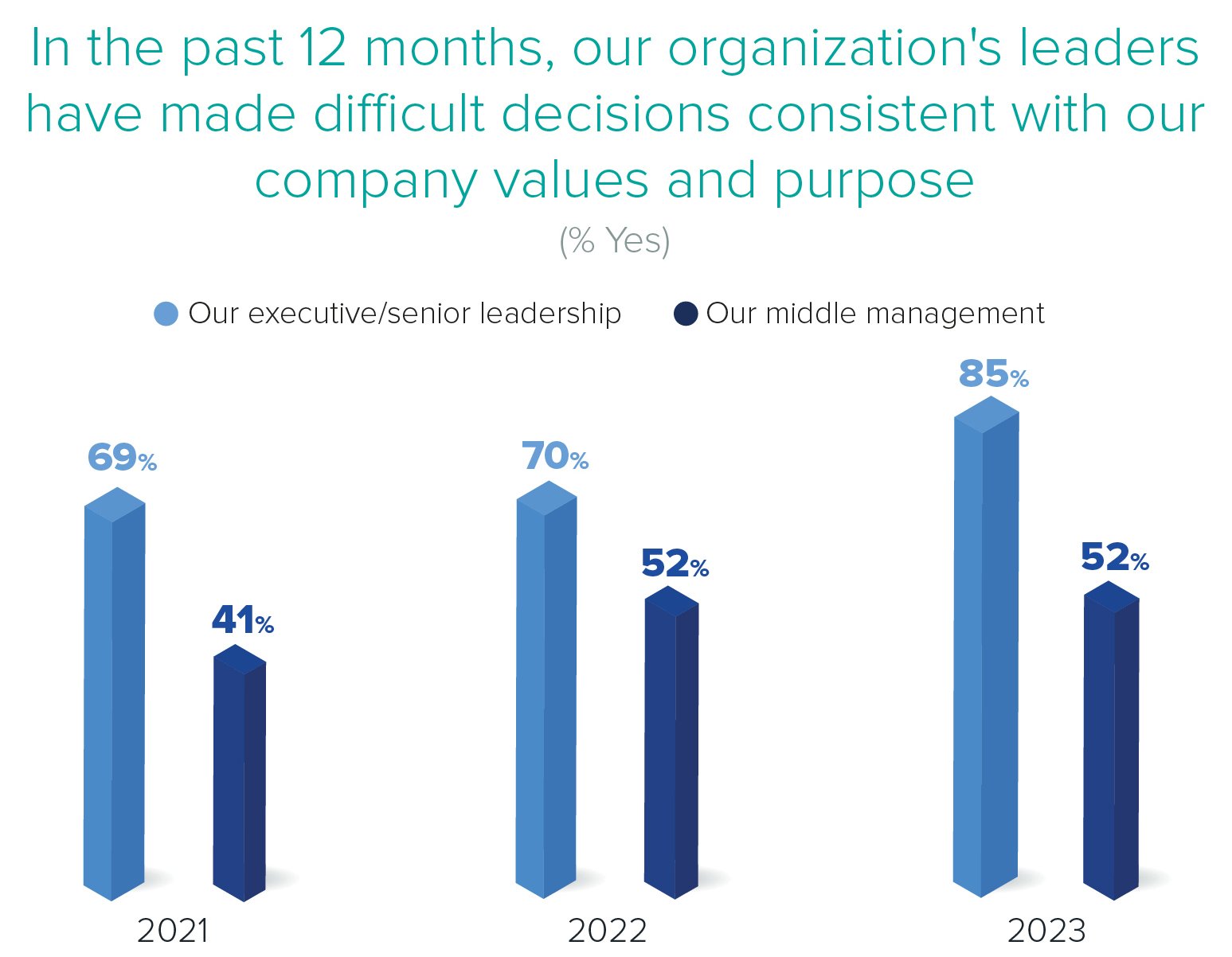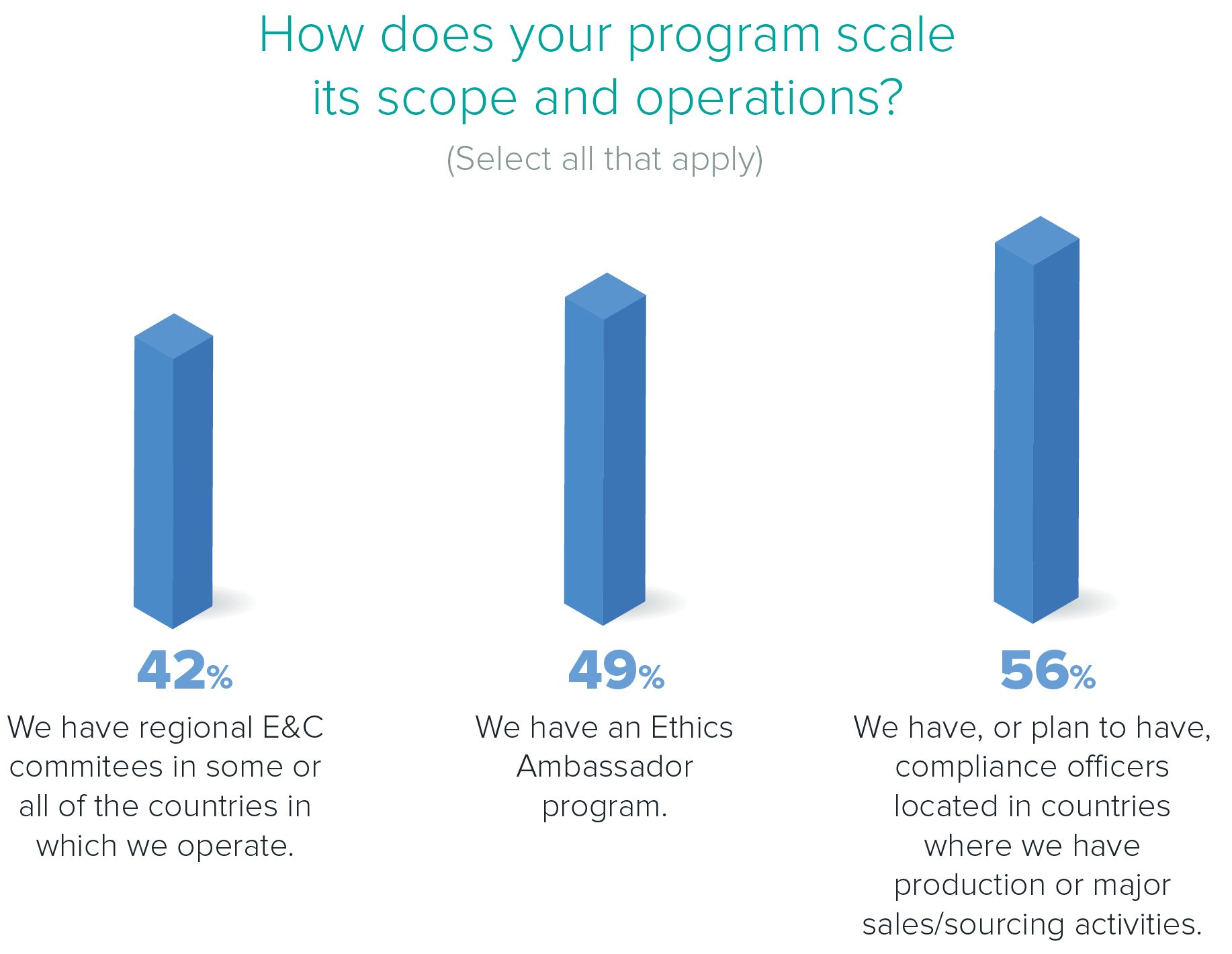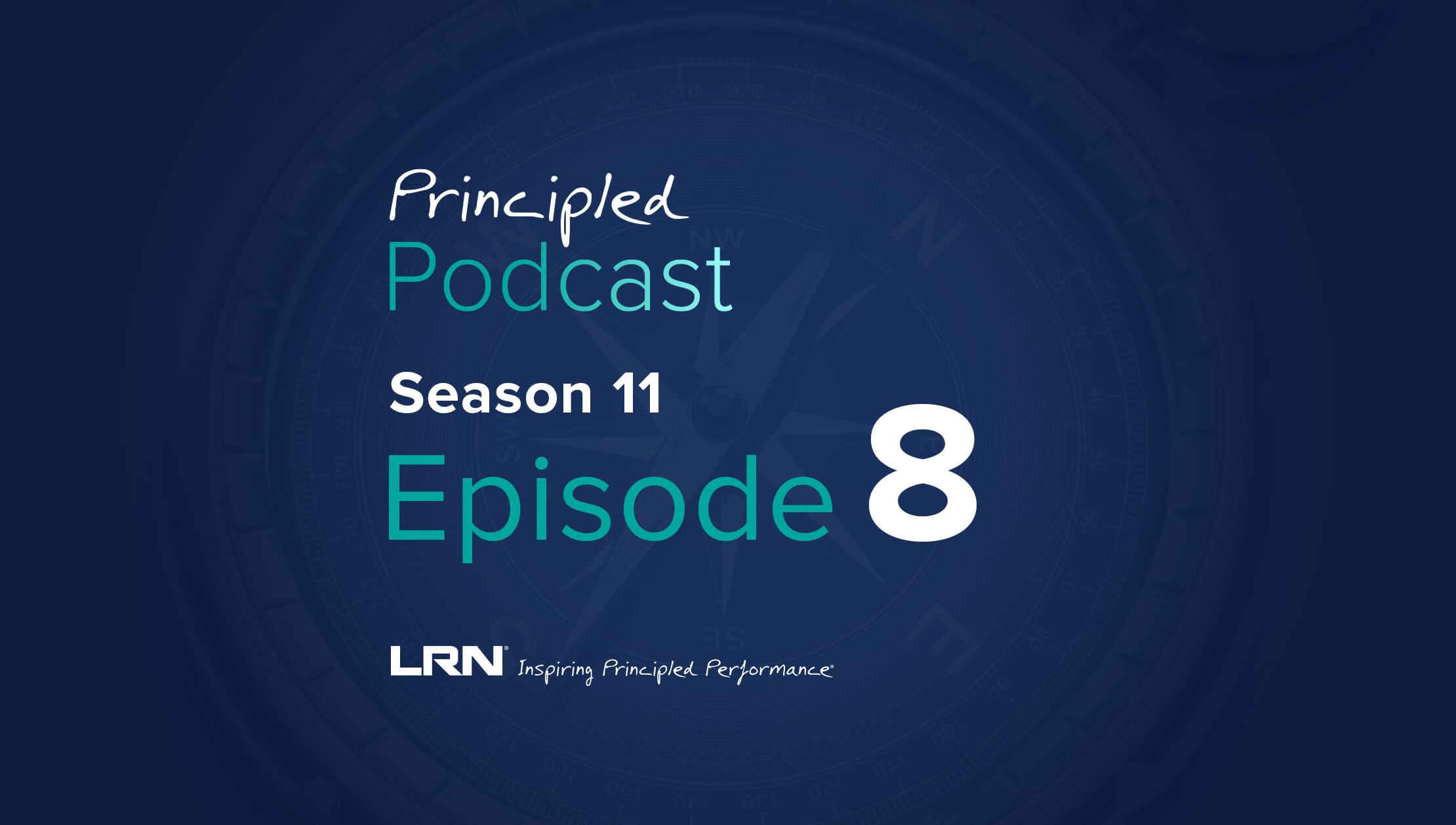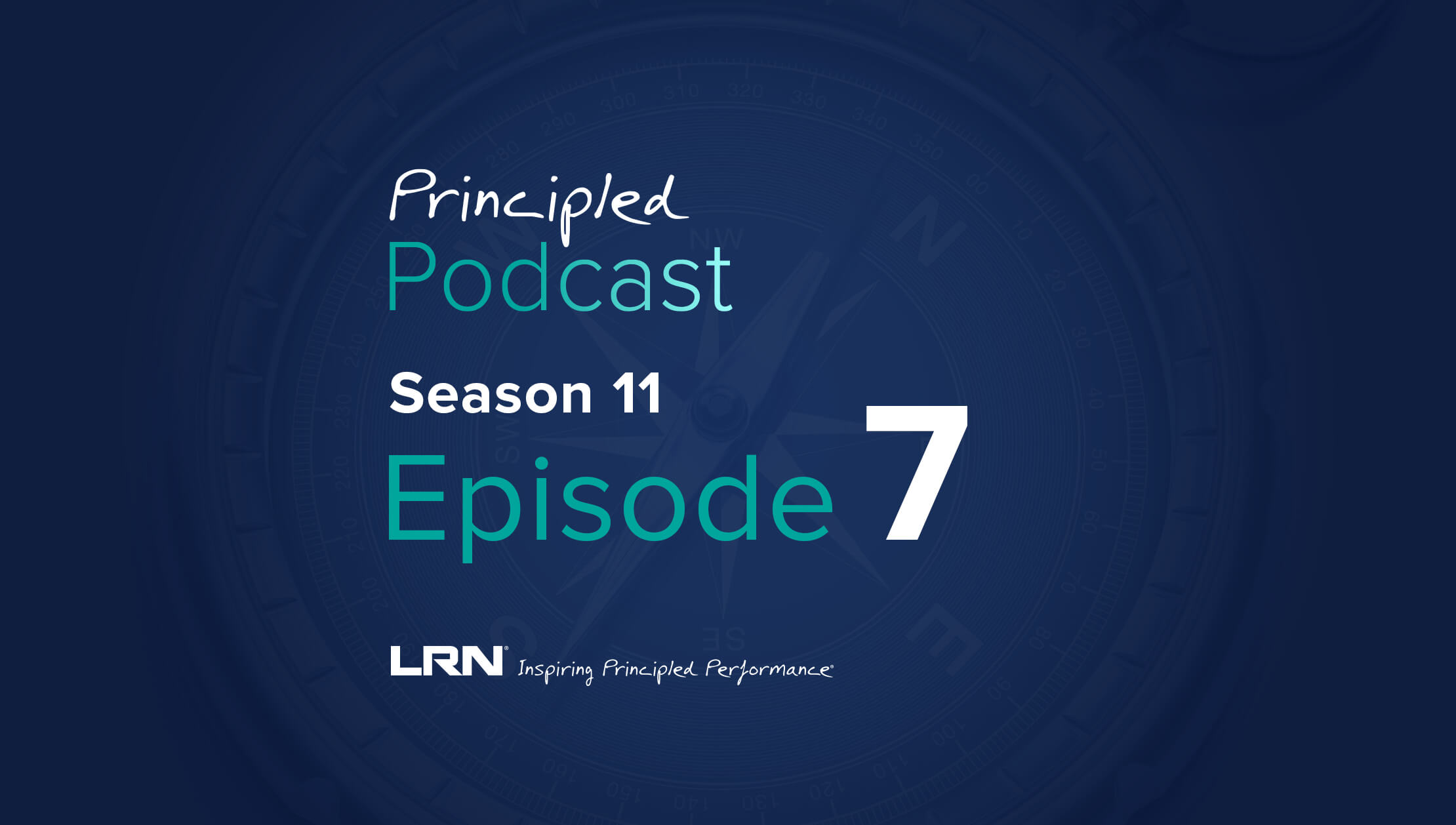As shared in our LRN 2024 Ethics and Compliance Program Effectiveness Report, corporate values are the “glue that holds together ethical culture and motivates everyone to do the right thing.” And while the percentage of organizations surveyed that use a values-based Ethics and Compliance (E&C) approach, as opposed to a policy, rules, and procedures-based program, has grown significantly over time, a stubborn and growing challenge remains: The Leadership divide.
What is the leadership divide?
Most organizations have wonderful ethical and purpose-based messages on their websites, often with quotes from CEOs on the organization’s commitment to sustainable business practices. But if those messages are not operationalized, they remain just that, aspirational. And who do people turn to when they face an ethical challenge or dilemma? As the research demonstrates (pioneered by Amy Edmondson in her iconic work The Fearless Organization), it's their supervisors: those are the people who can amplify those thoughtful 'tone at the top’ messages to those who face real-world risks in their work and roles. As shared in our LRN Report, middle-level managers “play a key role in balancing business goals and ethics.” They are uniquely qualified to help those on the front-lines to have a balanced mindset between ‘risk and success’ and to close that leadership divide through the ‘power’ of their voices and setting ethical expectations to their teams.
As stated by Juliana Rodrigues, Global Chief Compliance Officer, Coty, on the LRN Principled Podcast, while leadership ethics and compliance training is essential, it’s the middle level managers that are tasked to deliver results, and “we need to create the same awareness that we created at the top, at the middle.” Indeed, as Denise Lee Yohn shares in her book, Fusion: How Integrating Brand and Culture Powers the World’s Greatest Companies, mid-managers “are uniquely positioned to show employees what the organization really values, which attitudes and behaviors are on-brand, and why they and their actions matter.”
But if we are not careful, those middle-level managers, who control the volume on ‘getting the business done’ and the importance of ‘how business gets done’ can discard or dilute those aspirational goals—not because they are looking to circumvent values and policies, but to meet the needs of business growth. Yohn calls that the “frozen middle.” And as our LRN Report demonstrates, those gaps in operationalizing E&C between “leadership and middle management continues to grow.” It is the highest gap since this data has been collected.


Hence, we have a leadership divide between stated values and the middle-level managers who are responsible for operationalizing them.
But what does this mean for me?
As our Report demonstrates and referenced in this insight summary, there have been tremendous gains in E&C programs, including meeting the needs of our remote and hybrid environment, improvements in the use of data, risk analysis, and due diligence. But as an E&C leader, even if you build a ‘world-class’ program, if it is not embraced and articulated by your middle managers, it will be viewed by the workforce as a “support function” and not a part of the corporate narrative, as in ‘we care about how business gets done, even if that means walking away from opportunities.’
How can we bridge this worrisome gap?
Based on our survey data, conversations with clients, and best practices, we have identified several scalable and high-impact solutions and strategies to make sure that ‘tone at the top’ gets amplified as it moves through the organizational chart, both internally and externally.
1. Ethics Ambassadors
While the concept of ‘ethics ambassadors’ has been around for quite some time, almost half of our survey respondents reported having Ethical Ambassador programs. We have seen high-impact initiatives where organizations develop programs across functions and regions, where people play a role in E&C campaigns and messages, and also serve as a ‘point of contact’ when people face a challenge or dilemma. While the Ambassadors are not E&C subject matter experts, they are trained on how to direct people to the best source of support when confronting an issue. As these Ambassadors come from across functions, including finance, HR, sales, and procurement, they are well-known in the organization and easy for people to ‘turn to’ when they need support.

Many of our clients have annual meetings for their Ambassadors to conduct workshops, share messages, and look at what initiatives would be helpful in the year ahead. We have seen several clients where there is now a waitlist to become an Ambassador as it’s become a source of personal and professional pride to be a part of such a forward-based and embedded E&C team.
2. Open Feedback Loops
As shared in our Report, our current environment is “not static and must evolve to meet new risks and situations.” Our global risk landscape is evolving rapidly, and we need to meet these new challenges quickly and efficiently. And who knows what those risks and challenges are more than the people who work in those regions and roles: our middle-level managers. But if they are not reaching out to you for help and support to address new and emerging risks, are you proactively reaching out to them to ask how things are going, and how you can help them, with open-ended questions including, “how can we support you?”
In today’s volatile global environment, these open feedback loops are critical. There are several ways we have seen these ‘open feedback loops’ started and maintained, from simple calls to those who we know face emerging risks, to ‘mini-pulse’ surveys to identify ‘hot spots’ and then to engage in additional training and communication initiatives. But we need to remember, as Amy Edmondson shares, “dangerous silence” where those who should be calling you for help and support are not, and you are not reaching out to them, won’t fix itself. We need to be intentional about having those conversations.
3. Don’t keep difficult decisions a secret.
We have seen organizations where leaders have made difficult decisions, including walking away from business due to the potential for an unethical and perhaps an illegal result. The challenge is that those decisions are most often not shared with the rest of the organization. But when they are shared widely, it sends such a strong message, especially to those mid-level managers: When you do ‘what’s right,’ even at the cost of business, not only do we ‘have your back’ in terms of your work and career growth, but we celebrate those moments throughout the enterprise.
As LRN consultant Richard Bistrong shared in a recently published Fast Company article, acknowledging and celebrating high integrity, not just financial performance, can have such a high impact on people and programs, mid-level managers included.
Key Takeaways
As our LRN Report shares “the gap between middle-level management and leadership continues to widen when looking at ethical decision-making involving trade-offs.” But as stated, this gap is also an opportunity “to assist managers in operationalizing organizational values more effectively.” All organizations face hard choices between the pressure to succeed and the pressure to comply, where values can get challenged. But if we want middle-level managers to feel that they are not in those ‘crosshairs’, we need to be more intentional about our messaging, education, and initiatives. Why? So that they feel empowered to make difficult choices, and to personally feel responsible for setting ethical expectations, not just through the compliance narrative, but through the corporate narrative, in other words, through the voice of business.



